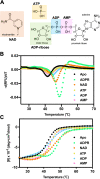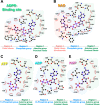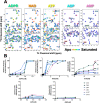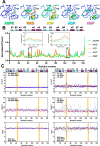Elucidating the tunability of binding behavior for the MERS-CoV macro domain with NAD metabolites
- PMID: 33504944
- PMCID: PMC7840908
- DOI: 10.1038/s42003-020-01633-6
Elucidating the tunability of binding behavior for the MERS-CoV macro domain with NAD metabolites
Abstract
The macro domain is an ADP-ribose (ADPR) binding module, which is considered to act as a sensor to recognize nicotinamide adenine dinucleotide (NAD) metabolites, including poly ADPR (PAR) and other small molecules. The recognition of macro domains with various ligands is important for a variety of biological functions involved in NAD metabolism, including DNA repair, chromatin remodeling, maintenance of genomic stability, and response to viral infection. Nevertheless, how the macro domain binds to moieties with such structural obstacles using a simple cleft remains a puzzle. We systematically investigated the Middle East respiratory syndrome-coronavirus (MERS-CoV) macro domain for its ligand selectivity and binding properties by structural and biophysical approaches. Of interest, NAD, which is considered not to interact with macro domains, was co-crystallized with the MERS-CoV macro domain. Further studies at physiological temperature revealed that NAD has similar binding ability with ADPR because of the accommodation of the thermal-tunable binding pocket. This study provides the biochemical and structural bases of the detailed ligand-binding mode of the MERS-CoV macro domain. In addition, our observation of enhanced binding affinity of the MERS-CoV macro domain to NAD at physiological temperature highlights the need for further study to reveal the biological functions.
Conflict of interest statement
The authors declare no competing interests.
Figures







Similar articles
-
Macro Domain from Middle East Respiratory Syndrome Coronavirus (MERS-CoV) Is an Efficient ADP-ribose Binding Module: CRYSTAL STRUCTURE AND BIOCHEMICAL STUDIES.J Biol Chem. 2016 Mar 4;291(10):4894-902. doi: 10.1074/jbc.M115.700542. Epub 2016 Jan 5. J Biol Chem. 2016. PMID: 26740631 Free PMC article.
-
NMR assignments of the macro domain from Middle East respiratory syndrome coronavirus (MERS-CoV).Biomol NMR Assign. 2016 Oct;10(2):245-8. doi: 10.1007/s12104-016-9676-9. Epub 2016 Mar 18. Biomol NMR Assign. 2016. PMID: 26993639 Free PMC article.
-
Differential activities of cellular and viral macro domain proteins in binding of ADP-ribose metabolites.J Mol Biol. 2009 Jan 9;385(1):212-25. doi: 10.1016/j.jmb.2008.10.045. Epub 2008 Nov 1. J Mol Biol. 2009. PMID: 18983849 Free PMC article.
-
New Insights into the Roles of NAD+-Poly(ADP-ribose) Metabolism and Poly(ADP-ribose) Glycohydrolase.Curr Protein Pept Sci. 2016;17(7):668-682. doi: 10.2174/1389203717666160419150014. Curr Protein Pept Sci. 2016. PMID: 27817743 Review.
-
The macro domain protein family: structure, functions, and their potential therapeutic implications.Mutat Res. 2011 May-Jun;727(3):86-103. doi: 10.1016/j.mrrev.2011.03.001. Epub 2011 Mar 21. Mutat Res. 2011. PMID: 21421074 Free PMC article. Review.
Cited by
-
Derivatives of MOPS: promising scaffolds for SARS coronaviruses Macro domain-targeted inhibition.FEBS J. 2025 Jun;292(11):2865-2881. doi: 10.1111/febs.70039. Epub 2025 Mar 11. FEBS J. 2025. PMID: 40070175 Free PMC article.
-
NMR study of macro domains (MDs) from betacoronavirus: backbone resonance assignments of SARS-CoV and MERS-CoV MDs in the free and the ADPr-bound state.Biomol NMR Assign. 2022 Apr;16(1):9-16. doi: 10.1007/s12104-021-10052-5. Epub 2021 Oct 22. Biomol NMR Assign. 2022. PMID: 34686999 Free PMC article.
-
Binding Adaptation of GS-441524 Diversifies Macro Domains and Downregulates SARS-CoV-2 de-MARylation Capacity.J Mol Biol. 2022 Aug 30;434(16):167720. doi: 10.1016/j.jmb.2022.167720. Epub 2022 Jul 15. J Mol Biol. 2022. PMID: 35839840 Free PMC article.
References
Publication types
MeSH terms
Substances
Grants and funding
- MOST 109-2628-B-002-037/Ministry of Science and Technology, Taiwan (Ministry of Science and Technology of Taiwan)/International
- MOST 108-2113-M-002-011/Ministry of Science and Technology, Taiwan (Ministry of Science and Technology of Taiwan)/International
- MOST 109-2113-M-002-003/Ministry of Science and Technology, Taiwan (Ministry of Science and Technology of Taiwan)/International
- NTU-CC-L893501/National Taiwan University (NTU)/International
- NTU-109L7734/National Taiwan University (NTU)/International
LinkOut - more resources
Full Text Sources
Other Literature Sources

